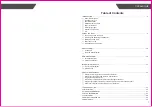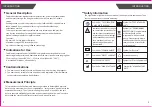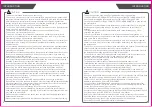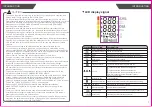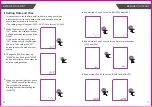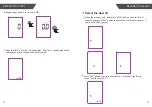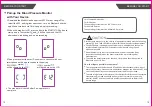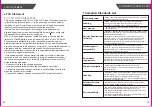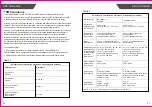
COMPLIED STANDARDS LIST
28
29
Complied Standards List
EN ISO 14971:2019 / ISO 14971:2019 Medical devices - Application
of risk management to medical devices
EN 1041:2008 +A1:2013 Information supplied by the manufacturer
of medical devices
EN 60601-1:2006+A1:2013+A12:2014 / IEC 60601-1:2005+A1:2012
Medical electrical equipment - Part 1: General requirements for basic
safety and essential performance
EN 60601-1-11:2015/ IEC 60601-1-11:2015 Medical electrical
equipment - Part 1-11: General requirements for basic safety and
essential performance - Collateral standard: Requirements for
medical electrical equipment and medical electrical systems used in
the home healthcare environment
EN 60601-1-2:2015/ IEC 60601-1-2:2014 Medical electrical
equipment - Part 1-2: General requirements for basic safety and
essential performance - Collateral standard: Electromagnetic
disturbances - Requirements and tests
EN ISO 81060-1:2012 Non-invasive sphygmomanometers - Part 1:
Requirements and test methods for non-automated measurement type
IEC80601-2-30:2018 Medical electrical equipment - Part 2-30:
Particular requirements for the basic safety and essential performance
of automated non-invasive sphygmomanometers
EN ISO 81060-2:2019/ISO 81060-2:2018, Non-invasive
sphygmomanometers - Part 2: Clinical validation of automated
measurement type
EN 60601-1-6:2010+A1:2015/IEC 60601-1-6:2010+A1:2013 Medical
electrical equipment - Part 1-6: General requirements for basic safety
and essential performance - Collateral standard: Usability
IEC 62366-1:2015 Medical devices - Part 1: Application of usability
engineering to medical devices
EN 62304:2006/AC: 2008 / IEC 62304: 2006+A1:2015 Medical
device software - Software life-cycle processes
Risk management
Labeling
User manual
General Requirements
for Safety
Electromagnetic
compatibility
Performance
requirements
Clinical investigation
Usability
Software life-cycle
processes
Bio-compatibility
ISO 10993-1:2018 Biological evaluation of medical devices- Part 1:
Evaluation and testing within a risk management process
ISO 10993-5:2009 Biological evaluation of medical devices - Part 5:
Tests for in vitro cytotoxicity
ISO 10993-10:2010 Biological evaluation of medical devices - Part
10: Tests for irritation and skin sensitization
EN ISO 15223-1:2016 / ISO 15223-1:2016 Medical devices.
Symbols to be used with medical device labels, labelling and
information to be supplied. Part 1 : General requirements
This device complies with Part 15 of the FCC Rules. Operation is subject
to the following two conditions: (1) this device may not cause harmful
interference, and (2) this device must accept any interference received,
including interference that may cause undesired operation.
Caution: The user is cautioned that changes or modifications not
expressly approved by the party responsible for compliance could void
the user's authority to operate the equipment.
NOTE: This equipment has been tested and found to comply with the
limits for a Class B digital device, pursuant to Part 15 of the FCC Rules.
These limits are designed to provide reasonable protection against
harmful interference in a residential installation. This equipment generates,
uses and can radiate radio frequency energy and, if not installed and used in
accordance with the instructions, may cause harmful interference to
radio communications. However, there is no guarantee that interference will
not occur in a particular installation.
If this equipment does cause harmful interference to radio or television
reception, which can be determined by turning the equipment off and on,
the user is encouraged to try to correct the interference by one or more
of the following measures:
-- Reorient or relocate the receiving antenna.
-- Increase the separation between the equipment and receiver.
-- Connect the equipment into an outlet on a circuit different from that to
which the receiver is connected.
-- Consult the dealer or an experienced radio/TV technician for help.
FCC Statement
FCC ID:OU9TMB1491BJ
FCC STATEMENT

